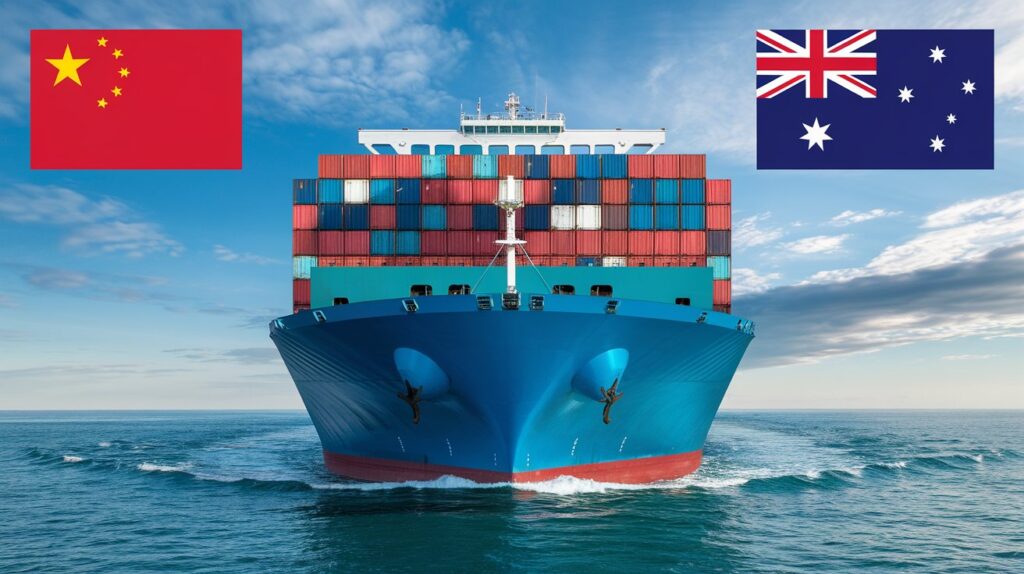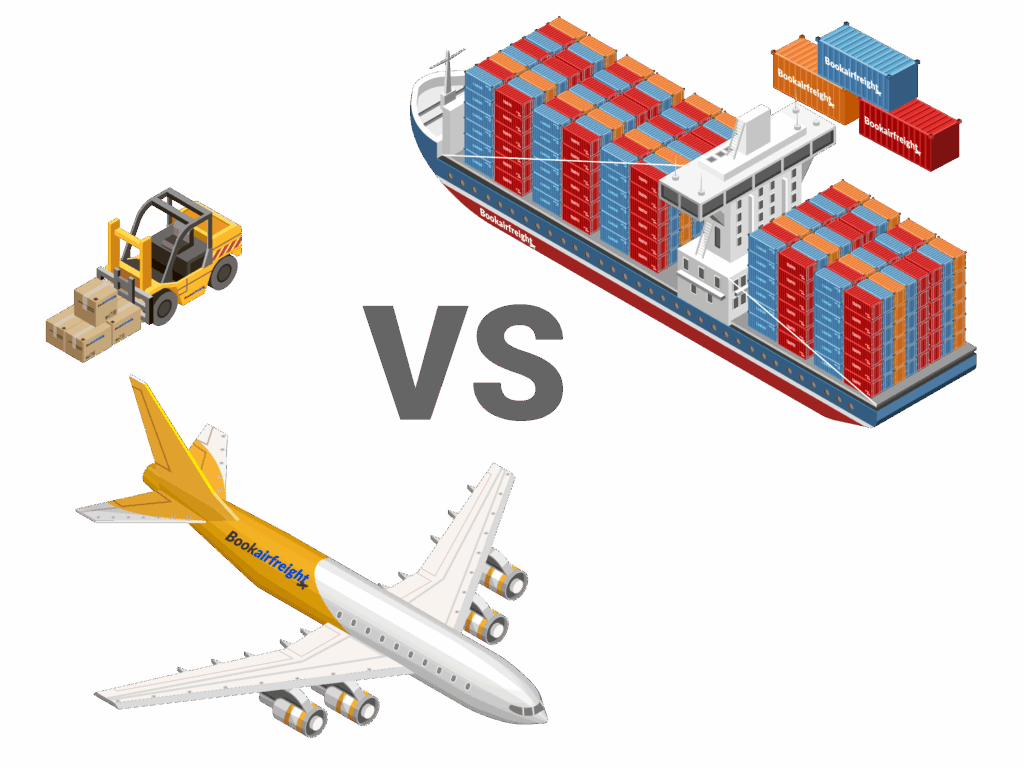- By TOP CHINA FREIGHT
- September 3, 2025
- Shipping
Table of Contents
Shipping goods from China to Australia is a critical part of global trade. Importers often face challenges such as varying shipping costs, customs clearance, and fluctuating transit times. This guide covers everything you need to know about China to Australia freight, providing practical insights and strategies to make your supply chain smoother.

What are the main shipping options from China to Australia?

When it comes to China to Australia freight, businesses typically choose between sea freight, air freight, express courier, and occasionally rail-air combinations. Each method offers distinct benefits depending on shipment size, urgency, and budget.
| Shipping Method | Average Cost (per kg or per CBM) | Transit Time (Days) | Best For |
|---|---|---|---|
| Sea Freight (FCL) | $2,000–$3,500 per 20ft container | 18–30 | Bulk cargo |
| Sea Freight (LCL) | $50–$80 per CBM | 20–35 | Small loads |
| Air Freight | $5–$9 per kg | 5–10 | Urgent shipments |
| Express Courier | $7–$12 per kg | 3–7 | Parcels & samples |
Therefore, the choice depends on weighing cost against speed, while also considering the nature of the products.
How much does China to Australia freight cost?

Freight costs are influenced by shipment size, destination port, and shipping method. For example, a 20ft container can cost between $2,000 and $3,500, while a 40ft container ranges from $3,800 to $6,000.
Additional factors that impact costs include:
1.Fuel surcharges and port fees
2.Customs duties and taxes
3.Peak season demand
4.Special handling for fragile goods
| Container Size | Average Cost Range | Typical Use |
|---|---|---|
| 20ft FCL | $2,000–$3,500 | Small shipments |
| 40ft FCL | $3,800–$6,000 | Larger volumes |
| LCL (per CBM) | $50–$80 | Shared cargo |
Therefore, businesses should always request multiple quotes to find competitive rates.
How long does it take to ship from China to Australia?
Transit time varies depending on origin and destination ports. Sea freight is the most commonly used and can take 18–35 days. In contrast, air freight takes just 5–10 days.
| Route Example | Transit Time by Sea | Transit Time by Air |
|---|---|---|
| Shanghai – Sydney | 18–22 days | 5–7 days |
| Shenzhen – Melbourne | 20–25 days | 6–8 days |
| Ningbo – Brisbane | 22–28 days | 6–9 days |
Moreover, customs processing and local delivery schedules can add a few days. Planning buffer time ensures goods arrive as expected.
What documents are required for China to Australia freight?
Declares value of goods for customs
Details packaging, weight, and volume
Transport contract between shipper & carrier
Identifies country of manufacture
Required by Australian Border Force
Should you choose sea freight or air freight from China to Australia?

Deciding between sea and air freight depends on cargo characteristics.
| Factor | Sea Freight | Air Freight |
|---|---|---|
| Cost | Low | High |
| Speed | Slow (18–35 days) | Fast (5–10 days) |
| Cargo Type | Heavy, bulky | Light, urgent |
| Environmental Impact | Lower per kg | Higher per kg |
For example, an electronics retailer needing urgent inventory restock would benefit from air freight despite higher costs. Conversely, furniture importers typically prefer sea freight due to the bulkiness of products.
What customs duties and taxes apply in Australia?

Import duties vary by product category, but most goods incur a 5% tariff unless covered by free trade agreements. Additionally, a 10% Goods and Services Tax (GST) applies to most imports.
Other possible charges include:
- Customs clearance fees
- Quarantine inspection fees
- Biosecurity charges
Therefore, businesses should budget beyond shipping costs to include these mandatory payments.
How do Incoterms affect China to Australia freight?
Incoterms define responsibilities between buyers and sellers. The most common in China to Australia freight are FOB (Free on Board), CIF (Cost, Insurance & Freight), and DDP (Delivered Duty Paid).
Buyer controls shipping after goods are loaded
Seller arranges freight and insurance until arrival port
Seller covers all costs, including customs clearance and delivery.
Case Study: Importing Electronics from Shenzhen to Sydney
A small Australian retailer needed to import 200 laptops from Shenzhen. They faced two options: sea freight (LCL) at $1,200 with a 25-day transit or air freight at $7/kg totaling $4,900 with a 6-day transit.
After assessing market demand, the company chose air freight. This decision allowed them to restock shelves before a promotional sale, generating revenue quickly. Although costs were higher, the faster delivery outweighed the expense, demonstrating how strategic freight choices can maximize profits.
What are the challenges in China to Australia freight?
Several challenges can impact smooth shipping:
- Seasonal congestion at ports
- Rising fuel surcharges
- Customs delays during inspections
- Quarantine requirements for agricultural products
However, working with an experienced freight forwarder can help navigate these issues and secure reliable schedules.
What trends shape the future of China to Australia freight?
Global logistics is evolving, and businesses must adapt.
Trends include:
- Digital freight platforms offering real-time tracking
- Greener shipping initiatives reducing carbon emissions
- Increased demand for express solutions in e-commerce
- More competition among carriers lowering rates
Therefore, keeping track of industry developments can improve long-term logistics strategies.
Conclusion
China to Australia freight involves multiple considerations such as costs, shipping methods, transit times, and customs compliance. Choosing between air and sea freight depends on budget and urgency, while accurate documentation ensures smooth clearance. Importers can reduce risks by planning ahead, comparing options, and partnering with reliable logistics providers. Ultimately, the right freight strategy enables businesses to save costs and enhance competitiveness in the Australian market.
Need a Shipping Quote?
If you want expert guidance and peace of mind, our team is ready to assist.
TJ China Freight offers tailored solutions to help businesses of all sizes ship more reliably from China.

FAQs
Q1:What is the cheapest way to ship from China to Australia?
The cheapest method is sea freight, especially Full Container Load (FCL). Although slower, it provides the lowest cost per unit of cargo. Businesses with bulk orders benefit most, as they can spread shipping costs over large volumes.
Q2:Do I need insurance for China to Australia freight?
Yes, insurance is highly recommended. It protects against risks such as damage, loss, or theft during transit. While carriers have limited liability, cargo insurance ensures full coverage, giving businesses peace of mind.
Q3:Can I ship small parcels from China to Australia?
Yes, express couriers like DHL, FedEx, and UPS provide fast and reliable services. Although more expensive per kilogram, they offer door-to-door delivery, which is ideal for samples, e-commerce parcels, or urgent small orders.
Q4:What goods require quarantine inspections in Australia?
Products such as wood, food, plants, and animal-based items often require inspections. Australia has strict biosecurity laws to protect its ecosystem. Importers should always check regulations before shipping sensitive goods.
Q5:How can I reduce shipping delays from China to Australia?
Planning ahead is crucial. Book shipments in advance, prepare documents accurately, and work with experienced freight forwarders. Additionally, avoiding peak seasons can significantly reduce the risk of delays.
